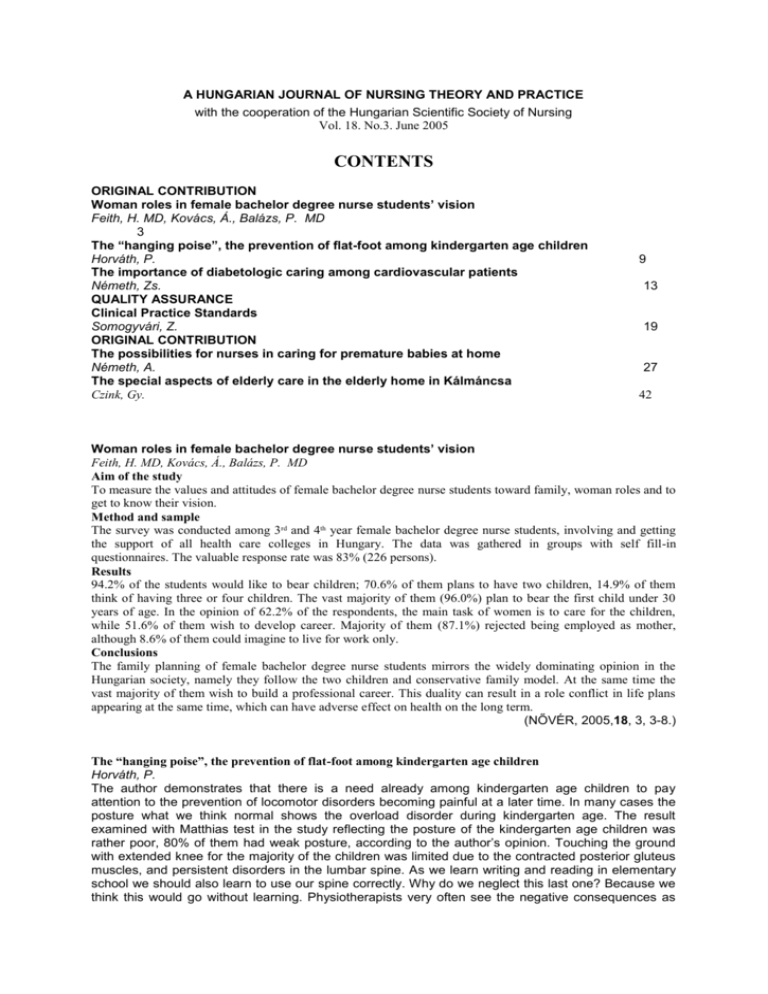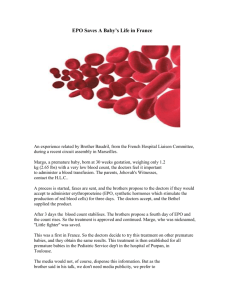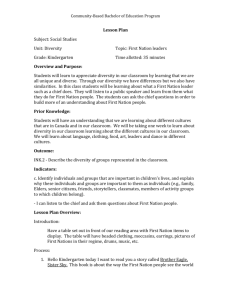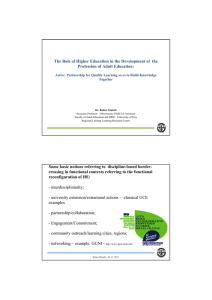A HUNGARIAN JOURNAL OF NURSING THEORY AND
advertisement

A HUNGARIAN JOURNAL OF NURSING THEORY AND PRACTICE with the cooperation of the Hungarian Scientific Society of Nursing Vol. 18. No.3. June 2005 CONTENTS ORIGINAL CONTRIBUTION Woman roles in female bachelor degree nurse students’ vision Feith, H. MD, Kovács, Á., Balázs, P. MD 3 The “hanging poise”, the prevention of flat-foot among kindergarten age children Horváth, P. The importance of diabetologic caring among cardiovascular patients Németh, Zs. QUALITY ASSURANCE Clinical Practice Standards Somogyvári, Z. ORIGINAL CONTRIBUTION The possibilities for nurses in caring for premature babies at home Németh, A. The special aspects of elderly care in the elderly home in Kálmáncsa Czink, Gy. 9 13 19 27 42 Woman roles in female bachelor degree nurse students’ vision Feith, H. MD, Kovács, Á., Balázs, P. MD Aim of the study To measure the values and attitudes of female bachelor degree nurse students toward family, woman roles and to get to know their vision. Method and sample The survey was conducted among 3rd and 4th year female bachelor degree nurse students, involving and getting the support of all health care colleges in Hungary. The data was gathered in groups with self fill-in questionnaires. The valuable response rate was 83% (226 persons). Results 94.2% of the students would like to bear children; 70.6% of them plans to have two children, 14.9% of them think of having three or four children. The vast majority of them (96.0%) plan to bear the first child under 30 years of age. In the opinion of 62.2% of the respondents, the main task of women is to care for the children, while 51.6% of them wish to develop career. Majority of them (87.1%) rejected being employed as mother, although 8.6% of them could imagine to live for work only. Conclusions The family planning of female bachelor degree nurse students mirrors the widely dominating opinion in the Hungarian society, namely they follow the two children and conservative family model. At the same time the vast majority of them wish to build a professional career. This duality can result in a role conflict in life plans appearing at the same time, which can have adverse effect on health on the long term. (NŐVÉR, 2005,18, 3, 3-8.) The “hanging poise”, the prevention of flat-foot among kindergarten age children Horváth, P. The author demonstrates that there is a need already among kindergarten age children to pay attention to the prevention of locomotor disorders becoming painful at a later time. In many cases the posture what we think normal shows the overload disorder during kindergarten age. The result examined with Matthias test in the study reflecting the posture of the kindergarten age children was rather poor, 80% of them had weak posture, according to the author’s opinion. Touching the ground with extended knee for the majority of the children was limited due to the contracted posterior gluteus muscles, and persistent disorders in the lumbar spine. As we learn writing and reading in elementary school we should also learn to use our spine correctly. Why do we neglect this last one? Because we think this would go without learning. Physiotherapists very often see the negative consequences as pain in the locomotor system. Among kindergarten age children posture and the muscles of foot-vault may and must be influenced indirectly by roleplaying. In the development of the foot muscles and the prevention of the posture disorders effective result can be achieved in a short time. (NŐVÉR, 2005, 18, 3, 9-12.) The importance of diabetologic caring among cardiovascular patients - form the point of view of health care workers Németh, Zs. Aim of the study Nowadays the term ‘cardio diabetes’ is used to feature the real risk of the clinical picture, the development of cardio and vascular complications. The basis for effective treatment is the full-scope awareness of patients. In my study I was seeking answer about the diabetic patients’ knowledge related to their disease and what are the reasons behind lack of knowledge. Study methods and sample In the study diabetic patients with cardiovascular complications were involved. 100 anonym self fill-in questionnaires were distributed. One part of the questions was examining the activity of health care workers, the other part was dealing with the motivation of the patients. Results The collected data points out the low level of the quality of the care. In the background the insufficient activitiy of caring team, lack of patients’ motivation, and the insufficiency of cooperation can be found. Conclusions There may be more explanation for inadequate care. The continuous education has equal importance with diagnostic and therapeutic tools. Only long-term life perspectives and tertiary prevention affecting work abilities can be taken into account in the case of evolved vascular complications. It is important that the function of the health care workers should not be limited only to diabetology departments or dispensaries, but it should be present in other fields as well. (NŐVÉR, 2005,18, 3, 13-17.) Clinical Practice Standards Somogyvári, Z. Quality improvement is a rather new, rather important field of the health care delivery system, which needs theories, methods, tools, experiences, training, training programmes, and implementation strategies of its own. A situation must be created where nurses can define their activitiy and prove it with documents, through continuous education and training. With aim of laying down the profession-specific requirements, the Ministry of Health issued the first and second version of the ‘Clinical Practice Standards’ (CPS). The groups of CPS follow the clinical pathways. According to my personal experience continuous, intensive, targeted and differentiated training and preparation through visual examples is necessary in order to interpret the standards appropriately (in the same language) and to understand them more easily. The well-defined, professional rules based description of the processes, the protocols built on the patients’ individual needs and documented, can match very well and if it is necessary they can be completed with the expectations defined in the CPS. The use of CPS in practice and the regular rethinking of processes reshaped the nurses’ outlook develops the professional self knowledge and the desire for striving high quality patient care. It has been accepted that inseparable part of nursing is the precise, sufficient documentation which provides safety and protection. (NŐVÉR, 2005, 18, 3, 19-24.) The possibilities for nurses in caring for premature babies at home Németh, A. Aim of the study To get information whether it is physical, mental or social problems that concern the parents with respect to their babies’ home care born under 2000 g; and to what extent and in which way they need advice to care for the baby at home and to correct the mistakes; and what expert they would take advice from. Study methods and sample A self fill-in questionnaire was used developed by the author. The non-representative sample involved mothers whose premature baby was born between 2003 and 2004 with birthweight less than 2000 g. Results There is no correlation between birthweight and the satisfaction with the information received in the hospital. Giving the information to the parents is not personalized and the birthweight does not influence the amount of the information passed by the health care workers. The questioned persons demand a preparatory program that helps the care for their infant at home. Conclusion Parents of low birth weight premature babies are very open to any information and preparatory programmes which promote the care, physical and sensorial development of their babies at home. This would allow to proceed a continuous habilitation of the premature babies at home after discharge. This would not only promote the development of the babies, but would also reduce the parents’ fear and tension during the difficult period. (NŐVÉR, 2005, 18, 3, 27-35.) The special aspects of elderly care in the elderly home in Kálmáncsa Czink, Gy. One of the characteristics of the demographic time change is that society is aging in the developed industrial countries. Its effects appear in the modification of societal roles (in the work, family, and in the field of social and health care). As a consequence, the old people resort to social services most frequently. Beside the deterioration of the health status of the elderly, mental health problems and psychological disorders also occur gradually. Based on the above, special attention should be paid to these aspects in the structure of the services in the homes for the elderly, with special regard to the fact that nowadays a reappraisal of old age is taking place, and the question of the quality of life and lifestyle comes to the front. (NŐVÉR , 2005, 18, 3, 42-44.)






